|
|
Post by Lee Martin on Mar 13, 2014 8:46:53 GMT -5
357 Maximum. L-to-R: Hornady early "jacket forward"180 FMJ over IMR 4227; Federal 180 JHP; Speer first production 180 TMJ over H110.  Ruger Maximum with Leupold 20x50mm spotter. 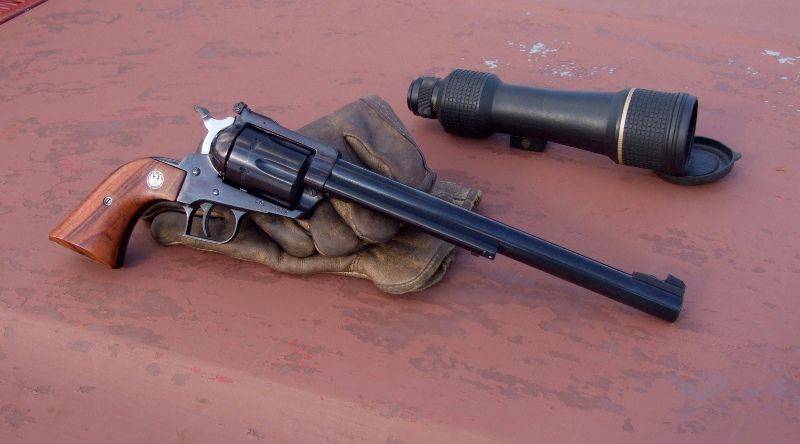  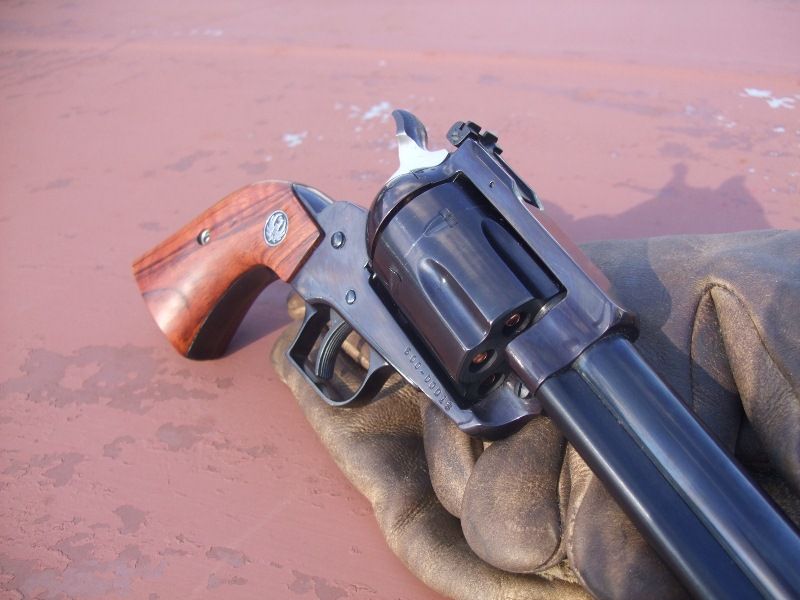 Ruger .357 Maximum at Home on the Range. 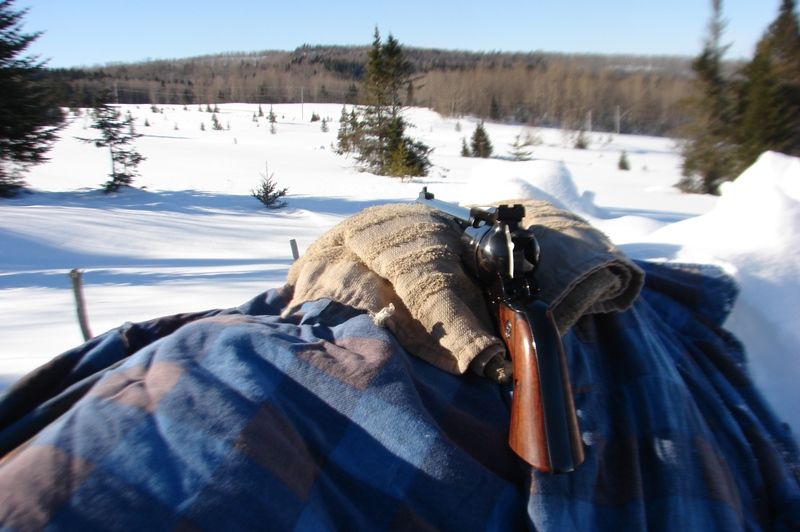 ....fell in the snowbank.  Revolver was due for a strip clean. 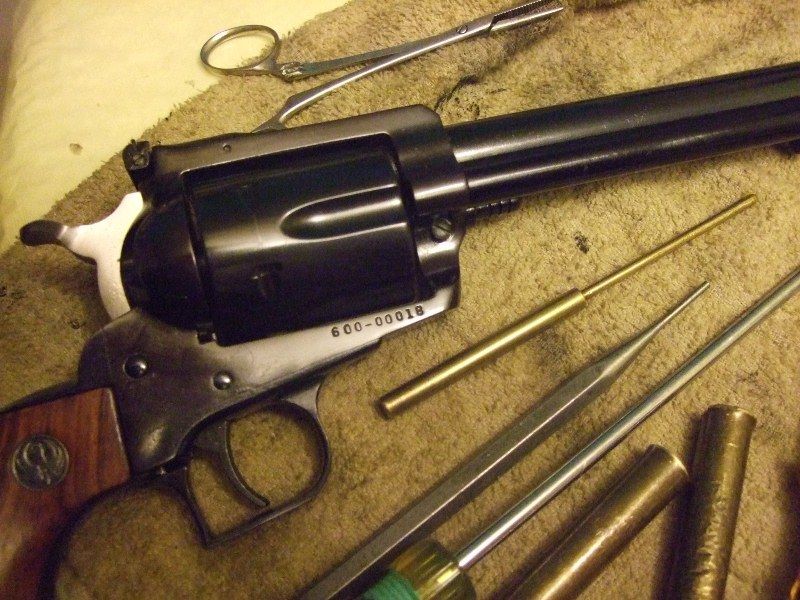 This is a short 11-degree forcing cone. First barrel had 5-degree forcing cone. Revolver unfortunately wiped with lint-infested rag before photo. Moly-disulfide grease on cylinder pin. 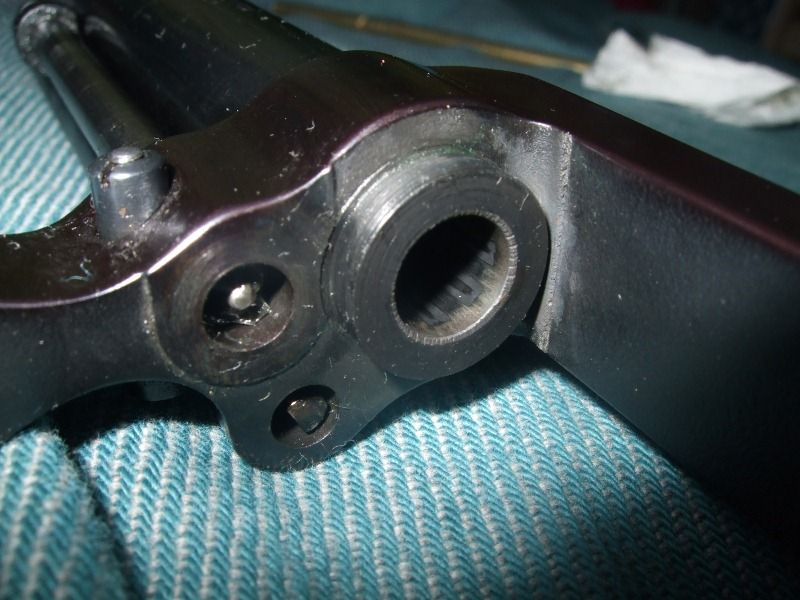 -Lee www.singleactions.com"Building carpal tunnel one round at a time" |
|
|
|
Post by bradshaw on Mar 13, 2014 10:06:29 GMT -5
Thank you, Lee.
Snow now lets up after storm of past two days piled it against windows. Both my cameras refused to fine-focus in the cold. Dug out three times yesterday, today will be the fourth. Commercial plowboys who wait out the storm to begin clearing will give the clutch and auto trans rebuilders plenty of work. Tractors and bulldozers are now in their element.
Last barrel Ruger installed on the .357 Maximum illustrates the short 11-degree forcing cone. A trend to over-deep forcing cones arose around 1979-80, as complaints of spitting came from volume consumers of magnum ammunition. Rather than address chamber-to-bore misalignment in production revolvers, manufacturers, namely Smith & Wesson and Ruger, drove the forcing cone deeper. "Timing" was a term much bandied about, as in "bad timing." Until we define our terms, timing is an abstraction. Timing covers everything from CARRY-UP and THROW-BY in the lockwork, to (more abstractly) chamber-to-bore alignment----which should be broken down into vertical and horizontal alignment.
The forcing cone is far more critical to revolver accuracy than the muzzle crown, which to this day some individuals insist is a life-or-death deal.
David Bradshaw
|
|
|
|
Post by bradshaw on Mar 13, 2014 10:37:14 GMT -5
Top photo with three .357 Maximum loads:
Left:
Hornady second generation silhouette bullet, truncated cone design. First generation used Full Metal Jacket Round Nose ("jacket forward" construction). Terrible accuracy from the FMJ round nose, you could watch them fly downrange like a corkscrew. Second generation shown still had FMJ, shortly replaced by the "jacket rearward" Truncated Cone SILHOUETTE bullet. These are 180 grains. Hornady sent me prototype jacket forward .357 200 grain FMJ TC, which featured a very long bearing surface.
The skirt of an FMJ is subject to FLARE under high pressure in a revolver with oversize forcing cone. Skirts have been know to separate at the crimp cannelure, even get left behind. This may, or may not, cause a ring as the next bullet is fired. Some T/C Contender barrels had a sharp LEADE, also known to separate the skirt----as nose jacket and core continued on.
Center:
Federal 180 JHP, the only factory .357 Maximum loaded by Federal Cartridge. A good hunting round. Federal stopped distribution of .357 Maximum ammo after experiencing spitting from Dan Wesson M40's in the lab, and not being able to resolve the issue.
Right:
Speer 180 TMJ loaded in Reming 1.605" case trimmed to 1.528", seated over 20/IMR 4227, with CCI 400 small rifle primer. This is the first generation production Speer .357 180 Total Metal Jacket. First experimental electroplated jackets were uneven and produced poor accuracy. Speer sorted out the problem and the rest is history, as in championships and records. Whereas the Hornady .357 200 grain silhouette bullet suffered from too long a jacket, the Speer 200 grain TMJ proved superior.
David Bradshaw
|
|
|
|
Post by Lee Martin on Mar 13, 2014 13:47:32 GMT -5
Excellent close-up of the forcing cone David. Any guess-timate of how many rounds it took to get there? -Lee www.singleactions.oom"Building carpal tunnel one round at a time" |
|
|
|
Post by bradshaw on Mar 13, 2014 19:25:14 GMT -5
Lee.... Guess in the low thousands. Have not kept track. Notably, a lot of shooting in cool and cold weather. And none of the sustained-hundreds-of-rounds-at-a-time fire which we inflicted on other Maximums and which heat carries an erosion component. And very little rocks & dynamite. Quite a bit of .357 Magnum, with a lesser component of .38 Special. Note, also, I see no evidence whatsoever of erosion from the shorter .38/.357 brass. The revolver has been fired with Maximum trimmed to various lengths, as well as the original 1.490" Maximum case. Most loads fired in SAAMI 1.605" case.
Top strap erosion represents exactly what Bill Ruger, Jr., observed in SRM prototypes, that the erosion, which begins immediately, tapers off sharply before 1,000 rounds. top strap erosion includes at least one other barrel.
David Bradshaw
|
|
|
|
Post by Doc Barranti on Mar 13, 2014 19:41:27 GMT -5
Always enjoy the photos!
I remember reading about these when they first came out and I wanted one real bad...never did get one though. After shooting a friend's Maximum at the Whittington Center a couple years ago, a 10.5" gun is on my long list.
I recall an article, can't remember the publication, by some guy I hadn't seen before. From what I remember, he took his Maximum on a successful deer hunt in the snow...I'm pretty sure that guy was you! Am I correct?
|
|
cmh
.401 Bobcat
  
Posts: 3,745
|
Post by cmh on Mar 13, 2014 19:42:04 GMT -5
That is one caliber I really look forward to pulling the trigger on. Thanks to you I know a lot more than most folks do about it..... Really appreciate the information you share  |
|
|
|
Post by bradshaw on Mar 14, 2014 11:18:48 GMT -5
Mr. Barranti.... a deer tracked in the mountains befell SRM-4 before the existence of a production Maximum. Perhaps you saw a photo of that.
Fine work, by the way, on your Skeeter Skelton leather, really beautiful tooling.
David Bradshaw
|
|
|
|
Post by Doc Barranti on Mar 14, 2014 12:25:19 GMT -5
That must be it...thanks...and I appreciate the compliment!
|
|
Deleted
Deleted Member
Posts: 0
|
Post by Deleted on Mar 14, 2014 14:44:56 GMT -5
i have an old issue of guns and ammo where Mr. Bradshaw unveils the .357 maximum. will have to do some digging to find it. good article from when guns and ammo was good to read.
|
|
|
|
Post by bradshaw on Mar 14, 2014 16:12:25 GMT -5
cmh and flexjr.... some exotic Rugers in that article, including the only transfer bar Hawkeye .357 Maximum, my photo of Bill Ruger, Sr., shooting SRM-2, and first prototype stainless Maximum. Bill Ruger, Sr., put six shots under six inches @ 100 yards, 70,000 psi, rheumatoid arthritis and all.
David Bradshaw
|
|
cmh
.401 Bobcat
  
Posts: 3,745
|
Post by cmh on Mar 14, 2014 16:18:15 GMT -5
Would really like to have a copy of that article  |
|
Deleted
Deleted Member
Posts: 0
|
Post by Deleted on Mar 14, 2014 16:31:27 GMT -5
holding the magazine in my hand now. March 1983 issue. That transfer bar hawkeye and the stainless maximum were two they should have built.
|
|
|
|
Post by bradshaw on Mar 14, 2014 16:54:03 GMT -5
Believe the revolver pictured in this thread, serial # 600-00018, albeit with different barrel, appears in lead photo, taken by Bill Ruger, Jr.
David Bradshaw
|
|
|
|
Post by squawberryman on Mar 17, 2014 8:26:13 GMT -5
Flex is there any way to get that article to these pages?
|
|